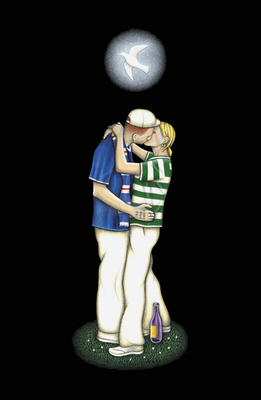.
One explanation for this paradox may be mistaken baseline
expectations. One person said her firm discriminated against
Catholics because only three out of ten people were Catholic.
Because we talk about the Catholic Church and the Kirk, Catholic
schools and state schools, and Rangers and Celtic as matching
pairs, it is possible to suppose that half of Glaswegians are
Catholic and, hence, only three Catholics in ten people needs
explaining. Actually, three in ten is a slight
over-representation, because Catholics make up only 25 per cent
of lowlands Scots.
We see the same paradox with violence. Two-thirds of the
Glasgow survey said sectarian violence was common or very
common, but less than 1 per cent had suffered any. When those
who had suffered various forms of abuse were asked the reasons,
it turned out that most violence was domestic. Residential area
was much more commonly cited than religion, as were gender and
sexuality. So, again, we have a mismatch. People think something
is widespread but somehow they have not experienced it.
This is what I mean by a social myth. How do we explain it? A
large part of the answer is that opinion-leaders such as
politicians and the mass media believe that sectarianism is a
major problem and that belief distorts their perceptions.
 The
Professor cites just two examples. Since June 2003, it has been
possible for a criminal offence to be "aggravated" by religious
prejudice. A mugger can now be hit with a second charge if he
calls his victim "a Proddie b******". Last November, the Crown
Office and the Procurator Fiscal Service released their analysis
of the first six months of the new system. The Daily Telegraph
was typical in leading with "Catholics are twice as likely as
Protestants to be the targets of sectarian abuse". What was not
stressed in the reporting was that, in more than 90 per cent of
cases, the original offence was breach of the peace, not murder,
robbery or assault. More than a third of the victims were police
officers, not civilians, and more than half the perpetrators
were drunk. More than a third of cases were associated with
football matches or Orange marches. And the sectarian abuse was
verbal.
The
Professor cites just two examples. Since June 2003, it has been
possible for a criminal offence to be "aggravated" by religious
prejudice. A mugger can now be hit with a second charge if he
calls his victim "a Proddie b******". Last November, the Crown
Office and the Procurator Fiscal Service released their analysis
of the first six months of the new system. The Daily Telegraph
was typical in leading with "Catholics are twice as likely as
Protestants to be the targets of sectarian abuse". What was not
stressed in the reporting was that, in more than 90 per cent of
cases, the original offence was breach of the peace, not murder,
robbery or assault. More than a third of the victims were police
officers, not civilians, and more than half the perpetrators
were drunk. More than a third of cases were associated with
football matches or Orange marches. And the sectarian abuse was
verbal.
This is not Nazis wrecking Jewish shops: it is young drunks
ranting at coppers and others who get in the way of their
inalienable right to get drunk and disorderly.
What was striking about this episode was that the Crown
Office (aided by uncritical reporting) created an entirely false
impression of Catholics as victims. The perpetrators do not know
the religion of their victims and nor do we. What we know is the
content of the verbal abuse. It tells us about the identity of
the abuser, not the abused. Two-thirds of the perpetrators
expressed anti-Catholic sentiments; one-third expressed
anti-Protestant sentiments. If the drunken hooligans of Glasgow
divide two-thirds Protestant and one-third Catholic, that is
about par for the area. Incivility is evenly distributed.
Second case: last November, the Sunday Mail reported the
burning down of a Catholic chapel in Stornoway under the banner
headline "Real toll of Old Firm mayhem". The police later
announced that the fire was caused by an electrical fault and
that no crime was suspected, but that fact did not get the
banner-headline treatment. Thus are myths sustained.



 The
Professor cites just two examples. Since June 2003, it has been
possible for a criminal offence to be "aggravated" by religious
prejudice. A mugger can now be hit with a second charge if he
calls his victim "a Proddie b******". Last November, the Crown
Office and the Procurator Fiscal Service released their analysis
of the first six months of the new system. The Daily Telegraph
was typical in leading with "Catholics are twice as likely as
Protestants to be the targets of sectarian abuse". What was not
stressed in the reporting was that, in more than 90 per cent of
cases, the original offence was breach of the peace, not murder,
robbery or assault. More than a third of the victims were police
officers, not civilians, and more than half the perpetrators
were drunk. More than a third of cases were associated with
football matches or Orange marches. And the sectarian abuse was
verbal.
The
Professor cites just two examples. Since June 2003, it has been
possible for a criminal offence to be "aggravated" by religious
prejudice. A mugger can now be hit with a second charge if he
calls his victim "a Proddie b******". Last November, the Crown
Office and the Procurator Fiscal Service released their analysis
of the first six months of the new system. The Daily Telegraph
was typical in leading with "Catholics are twice as likely as
Protestants to be the targets of sectarian abuse". What was not
stressed in the reporting was that, in more than 90 per cent of
cases, the original offence was breach of the peace, not murder,
robbery or assault. More than a third of the victims were police
officers, not civilians, and more than half the perpetrators
were drunk. More than a third of cases were associated with
football matches or Orange marches. And the sectarian abuse was
verbal.